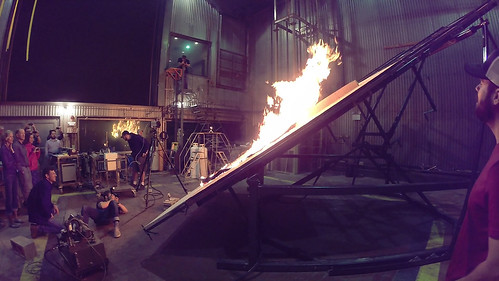
Researchers prepare for the next phase in examining physical fire processes by adding the effect of a slope. Photo credit: Mark Finney
In recent months, we have all become familiar with images in the media of wildland firefighters digging lines, air tankers dropping retardant and fire engines dispersing water. You may wonder “how do these firefighters know what it takes to fight fire?”
The short answer is: research.
Before a wildland firefighter sees his or her first fire, they are given the tools and training on how to fight fire and its behavior. The information passed onto them is not learned overnight but rather through years of research.
In the US Forest Service’s Missoula Fire Sciences Laboratory, in Montana, employees conduct research on flame, smoke, fuel types and how fire spreads. The lab has six different focus areas including one called the Physical Fire Processes which studies the fundamental physics of fire spread. Another one, Fuel Dynamics, works to make the process of fire behavior and its effects more accurately predictable, and the Smoke Emissions and Dispersion area’s focus is on a better understanding of smoke movement from fires and potential impacts. Other focus areas concentrate on the effects of fire on plants and the study of how a forest responds to fire disturbances and climate change.
Fire and firefighting have been around for centuries, so what else can we learn? The answer is a lot. In fact, we learn more each day.
For example, in 2015 the lab received an award for its research in buoyant flame dynamics in wildfire spread. As everyone knows, fire is hot, but the question that remained unanswered was “how is heat from a fire transferred to other fuels like pine needles so that it spreads?”
Our lab researchers discovered convection, or hot gasses bursting rapidly forward from the flames, which occurs by contact of air or fluid moving past an object, transferred fire. Before this discovery, most scientists had considered radiation, the heat we feel from the sun or a fire, to be the key heat transfer mechanism in wildfires. The research showed that flame and hot gasses are forced into contact with new fuels because the rising motion of hot flames actually causes downward flow of cooler replacement air nearby. Thus flames form an alternating pattern of up and down motions along a fire front, and these motions cause the air to spin in the direction wind is moving.
After reading about the research our agency has been doing, you might have some ideas yourself, such as having the Forest Service test a new retardant (something that can be very time consuming and expensive). If you would like more information, contact the Missoula Technology and Development Center at 406-329-3900.
No comments:
Post a Comment
Note: Only a member of this blog may post a comment.